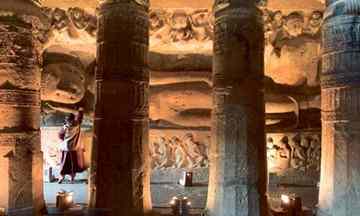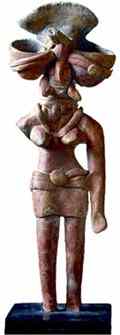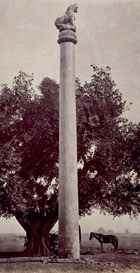More than four millennia have passed since the many artefacts of the ancient Indus civilisation were fashioned. Yet one tiny sculpture, made by an unknown artist, still seems strikingly relevant to us today.
 The seal shows a seated figure on a low platform in a pose that is familiar to modern practitioners of yoga and meditation: the knees spread to the sides with the feet touching, and the arms stretch from the shoulders away from the body with the fingertips resting on the knees.
The seal shows a seated figure on a low platform in a pose that is familiar to modern practitioners of yoga and meditation: the knees spread to the sides with the feet touching, and the arms stretch from the shoulders away from the body with the fingertips resting on the knees.
Assuming the symmetrical and balanced form of a triangle, the body of the adept thus posed can endure lengthy sessions of yoga and meditation without needing to shift.
The word yoga means "to unite" and ancient yoga was intended to prepare the body for meditation through which the individual would seek to understand his or her oneness with the totality of the universe.
Once this understanding was complete, people could no more hurt another living being than themselves. Today, such practices are routinely prescribed to complement western medical and psychotherapy treatments.
Among the documented benefits of yoga and its corollary, meditation, are lowered blood pressure, greater mental acuity and stress reduction.
To the ancients who developed and perfected these mentally and physically challenging methods, however, yoga and meditation were tools for finding inner peace and a harmonious existence.
Once you look closely, plenty more evidence points to the non-violent, peaceful nature of these early peoples. For example, the archaeological remains of the cities and towns of the Indus civilisation during its florescence from c2300-1750BC show little if any indication of internal dissent, criminality, or even the threat of war and conflict from the outside. There are no known fortifications, nor is there proof of ransacking and pillaging.
There is also an emphasis on citizenship rather than a ruling elite in this period. Indeed, archaeological evidence suggests there was, in fact, no hereditary ruler – such as a king or other monarch – that amassed and controlled the wealth of the society.
Thus, in contrast to the other ancient civilisations of the world, whose vast architectural and artistic undertakings, such as tombs and large-scale sculptures, served the wealthy and powerful, the Indus civilisation leaves nothing in the way of such monuments.
Instead, government programmes and financial resources seem to have been directed towards the organisation of a society that benefited its citizens.
Another feature that sets the ancient Indus culture apart from other early civilisations is the prominent role played by women. Among the artefacts we have been able to unearth are thousands of ceramic sculptures representing women, sometimes interpreted as goddesses, and, specifically, mother goddesses.
This is a core element in the major religious developments of India, which are populated with goddesses – some supreme and others whose role is to complement male deities who would otherwise be incomplete or even powerless. It is thus hardly surprising that the symbol chosen for the nationalistic independence movement of the early 20th century and the establishment of India's modern democracy was Bharat Mata – that is, Mother India.
Cradle of faiths
The area's first ancient culture, the Indus or Harappan civilisation, was at its peak centred in what is now Pakistan in the northwestern reaches of south Asia. It stretched southward for a thousand miles along the western coastal areas of India.
It eventually disappeared around 1750BC, because of a combination of natural and human factors. Earthquakes in the high Himalayas may have changed the course of the rivers that provided life-sustaining agricultural irrigation, leading to the abandonment of cities and towns and relocation elsewhere.
 In addition, the ancient inhabitants, unaware of the need to replant as they cut down trees to use for building and fuel, deforested the region, thus contributing to its transformation into the desert of today.
In addition, the ancient inhabitants, unaware of the need to replant as they cut down trees to use for building and fuel, deforested the region, thus contributing to its transformation into the desert of today.
The period that followed the Indus civilisation from c1750BC to the third century BC has left a spotty material record. But we know it was in this time that some of the most important principles of Indic civilisation appeared. Some of these precepts come from the Indus culture, but other ideas arrived in India from the outside, such as with the nomadic, Indo-European Aryans from central Asia.
Perhaps the most important figure to emerge in this period was the historical Buddha, born Siddhartha Gautama in the Ganges river region of northern India in the sixth century BC. Attaining perfect knowledge at the age of 36, after a quest that involved ascetic and meditational practices, the Buddha taught what is known as the Middle Way, advocating the abandonment of both extreme asceticism and extreme luxury.
The Buddha also taught that all living beings have the capacity to transform themselves from an ignorant, self-centred state to one that embodies unqualified goodwill and generosity. Enlightenment was a matter of personal responsibility: every person had to develop wisely directed compassion for all living beings along with perfect knowledge of their role in the universe.
It's important to note that the historical Buddha is not considered a divine being and his followers do not worship him – rather, they revere and honour him through their practices. In art, he is shown as a human, not a superhuman being. Because there is no all-powerful central deity in Buddhism, the religion is easily compatible with other traditions and there are many people throughout the world today who combine Buddhism with another faith.
Jainism
A contemporary of Buddha was Mahavira: the 24th in a line of perfected human beings known as jinas, or victors, and a major figure in the Jain religion. Like the Buddha, Mahavira is not considered a god but an exemplar to his followers. When depicted in art, he and the other 24 jinas appear as highly perfected humans.
Unlike Buddhism and Jainism, India's third major indigenous religion, Hinduism, did not have a human teacher to whom the beliefs and practices of the tradition may be traced. Instead, it is centred around devotion to specific deities, both supreme and minor, who are numbered among a vast pantheon of gods and goddesses.
Shiva destroys the universe with his cosmic dance when it has deteriorated to the degree that it needs to be reborn; Vishnu is the protector and preserver of the world as it struggles to maintain stasis. Archaeological evidence for Hinduism appears later in India's material record than those of Buddhism and Jainism, and stone and metal artefacts portraying the host of deities are rare before the fifth century AD.
All three of these Indic religions share the belief that every living being is subject to a cycle of birth and rebirth over countless aeons. Known as samsara, this cycle of transmigration is not limited to humans but includes all sentient beings.
The form one will take in a future birth is determined by one's karma – a term that in modern parlance has come to mean little more than "luck", but the original Indic use of the word specifically refers to one's actions, which are the result of choice, not chance.
The escape from samsara, called nirvana by Buddhists and moksa by Hindus and Jains, is the ultimate goal of each of the three religious traditions, and all human activity should, ideally, be directed towards improving one's karma to achieve this end.
Although today we assign different names to these three religious traditions, in many ways they are considered different paths, or margs, toward a similar objective. Within Indic culture, and indeed even within families, individuals have been free to choose their own marg, and we have no evidence of religious conflict among these traditions.
Greece meets India
Around the third century BC, a mix of internal cultural evolution and stimulating contact with ancient western Asia and the Mediterranean worlds brought change to the Indic regions.
The arrival of Alexander the Great in the northwestern region of south Asia in 327BC, and the collapse of the ancient Persian Empire, introduced new ideas – including the development of the concept of kingship, and technologies such as the tools and knowledge necessary for large-scale stone carving. Had Alexander succeeded in conquering the Indian subcontinent – mutiny and fatigue among his troops is said to have caused a retreat – one can only imagine how Indian history might have evolved.
As it stands, his legacy is mainly cultural, not political, as the pathways across western Asia that he forged remained open for trade and economic exchange for centuries after his death.
 One thing to pass through this gateway was a system of rule by kingship, which took hold of northern India in the rich lands fertilised by the life-giving Ganges river. The most renowned of India's first kings was Ashoka, who even today is admired by India's leaders as a paradigm of the benevolent ruler.
One thing to pass through this gateway was a system of rule by kingship, which took hold of northern India in the rich lands fertilised by the life-giving Ganges river. The most renowned of India's first kings was Ashoka, who even today is admired by India's leaders as a paradigm of the benevolent ruler.
After years engaged in waging war to aggrandise his empire, Ashoka, having seen some 150,000 people carried away as captives, 100,000 more slain, and many more dead after his final conquest, was struck with remorse at the suffering he had caused.
Converting to Buddhism, Ashoka spent the remainder of his life in righteous, peaceful activities. His benevolent kingship was adopted as a model throughout Asia as Buddhism moved beyond its Indic homeland.
The set of four lions portrayed on one of his most famous monuments – the stone pillar he erected at Sarnath, where the Buddha taught his first sermon – has become a ubiquitous symbol of India's modern democracy, and is used on coins, stamps, government stationery, and elsewhere to laud the modern nation's roots in enlightened rulership.
Legacy
As suggested by the artefacts that have survived and what we know about the religious and philosophical beliefs of the people, the period 2500BC-AD500 in ancient India was one of extraordinary cultural brilliance, with innovations and traditions that still leave their mark on the world today.
Furthermore, the cultural continuity between India's past and present is unmatched in the other regions of the world. The modern societies in Egypt, Mesopotamia, Greece, Rome, the Americas and China for the most part bear little resemblance to their ancient counterparts.
Indeed, what is striking from an overview of the early phases of India's long and rich cultural development is the fact that so many of the features in evidence through the material record have had a persistent and lasting effect on Indic society and the world.
Ancient India's legacy in the fields of science and mathematics is significant. Mathematics was important to the layout of religious buildings and the philosophical comprehension of the cosmos.
The fifth century AD astronomer and mathematician Aryabhata is credited with originating the modern decimal system, which is predicated on an understanding of the concept of zero.
Evidence of the Indic origin of the idea of zero, including the use of a small circle to denote the numeral, is found in Sanskrit texts and inscriptions.
Science of life
Another cultural legacy is an ancient branch of medicine known as Ayurveda, still widely practiced in India today. It has also gained popularity in the western world as a "complementary" medicine. Translating literally as "science of life", it conceives basic principles for human health and points to physical and mental balance as the means to wellbeing.
Perhaps ancient India's most lasting legacy is the belief in non-harm to living beings – a centrepiece of Buddhism, Jainism and Hinduism – which was transformed into the passive resistance advocated by Mahatma Gandhi during India's early 20th century struggle for independence from British rule.
After Gandhi, many other modern luminaries have been guided by the principle of non-violence in their quests for social justice, most famously Reverend Martin Luther King, who spearheaded the struggle for racial equality in the US during the 1960s. In his autobiography, King notes that "Gandhi was the guiding light of our technique of non-violent social change" during the bus boycott in 1956 that ended Alabama's transport segregation on the city's buses.
John F. Kennedy, Nelson Mandela and Barack Obama have also claimed inspiration from Mahatma Gandhi and the ancient Indian principle of non-harm, and the Indic compassion towards all living beings and the corresponding non-violent stance has been adopted by groups that advocate vegetarianism, animal welfare and environmental activism.
Perhaps there is no greater compliment that can be paid to India's ancient culture than the fact that its sophisticated beliefs and reverence for life can serve as guideposts to the world today.
Author: Susan Huntington | Source: Guardian [November 12, 2010]